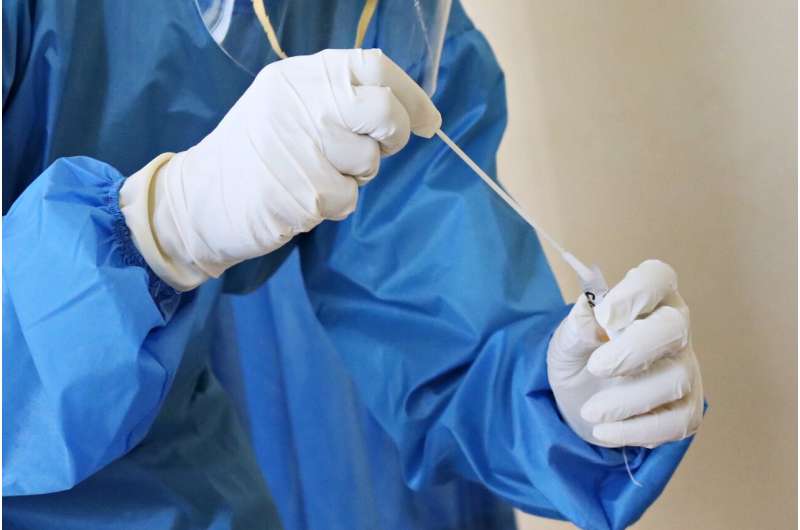A laboratory worker takes a swab test. Credit: Mufid Majnun, Unsplash, CC0 (creativecommons.org/publicdomain/zero/1.0/)
The earliest batch of COVID-19 tests distributed by the US Centers for Disease Control and Prevention (CDC) exhibited false positive reactivity of negative controls due to flaws in assay design and contamination in one of the assay components, according to a CDC internal investigation published this week in the open-access journal PLOS ONE.
The complete SARS-CoV-2 genome sequence from a patient in Wuhan, China was published on January 12, 2020 and CDC scientists began rapid development of a Real-Time RT-PCR Diagnostic Panel to detect the novel coronavirus. The first RT-PCR panel, distributed to US state public health laboratories beginning February 5, 2020, was designed to recognize three unique spots, or "loci" on the SARS-CoV-2 genome. Within several days of distribution, CDC received reports from multiple laboratories of false positive reactivity in the negative controls generated by two of the three probes, known as N1 and N3. This led to changes to the panel, including the removal of the N3 probes.
In the new study, CDC researchers reviewed the design, validation, manufacturing and distribution of the diagnostic panel. The team concluded that one source of the false positive reactivity of the negative control was contamination of the N1 component of the RT-PCR kits by a synthetic piece of genetic material. The N1 contamination was detected in the initial production lot of distributed kits, resulting in approximately 2% false positives, but the pre-validation material was not contaminated (0% false positives). The researchers therefore determined that the N1 contamination—which has since been resolved—occurred during the post-production quality control process or packaging of the kits.
Meanwhile, false positive reactivity of the negative control from the N3 probe was due to a design flaw, the scientists report. Two molecules in the N3 probe frequently bound to each other in the absence of any virus, triggering the fluorescence that signals a positive reaction. This false positive reactivity of the negative control increased with the age of the RT-PCR test kits, which could explain why early evaluation runs, using newly produced materials, did not see high levels of false positives.
The team says that this issue with false positive reactivity of the negative control has since led to improvements in quality control, quality assurance and assay validation for RT-PCR and other diagnostic tests at the CDC. These changes include additional steps of review and approval by experts independent of the diagnostic panel design team, as well as piloting the diagnostic panels with public health laboratories to confirm functionality and usability.
For additional information, see CDC's webpage on laboratory quality improvement activities, (www.cdc.gov/labs/quality-activities.html).
More information: Lee JS, Goldstein JM, Moon JL, Herzegh O, Bagarozzi DA Jr, Oberste MS, et al. (2021) Analysis of the initial lot of the CDC 2019-Novel Coronavirus (2019-nCoV) real-time RT-PCR diagnostic panel. PLoS ONE 16(12): e0260487. doi.org/10.1371/journal.pone.0260487
Journal information: PLoS ONE
Provided by Public Library of Science
























